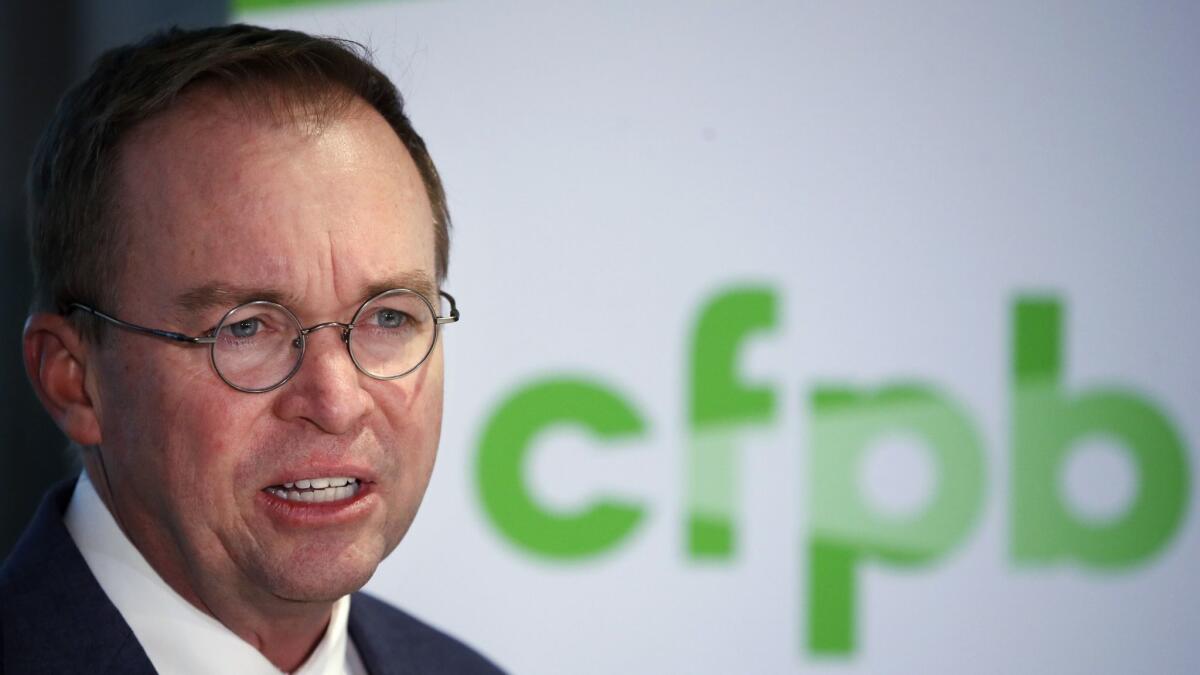‘Consumer’ may get a demotion if Mick Mulvaney’s CFPB overhaul includes altering its name

Reporting from Washington — Mick Mulvaney’s overhaul of the Consumer Financial Protection Bureau is so extensive it now could include revising the agency’s name and discarding its simple, modern logo.
Mulvaney, installed as acting director by President Trump last fall, has taken to calling the agency the Bureau of Consumer Financial Protection in formal correspondence. Then, last month, his staff unveiled the bureau’s first-ever official seal, which formalized that name, written in full above an eagle with its wings raised over a shield featuring symbols for justice, consumer financial security and transparency.
For the record:
11:40 a.m. April 11, 2018An earlier version of this article reported that the Consumer Financial Protection Bureau’s seal was unveiled this month. It was unveiled March 30.
Consumer advocates worry that the wording change and old-fashioned-looking seal are part of a broader strategy by Mulvaney, an outspoken critic of the agency he now heads, to undermine its mandate by making it sound more bureaucratic and de-emphasizing the word “consumer.”
He changed the bureau’s mission statement in December to make the top priority “identifying and addressing outdated, unnecessary, or unduly burdensome regulations.” He also publicly declared that the bureau no longer would “aggressively push the envelope” to protect consumers.
“I have no doubt that this goes hand-in-hand with their other efforts to stymie the bureau’s mission to protect consumers and hold industry accountable,” said Karl Frisch, executive director of Allied Progress, a consumer watchdog group.
“The name change, the reconfiguring of its mission…the new [seal], all of that is designed to dull the popular support the bureau receives when people hear about it by making it sound more bureaucratic and less effective,” he said.
Under its first director, Democrat Richard Cordray, the bureau aggressively pursued consumer abuses.
Since opening in 2011, it provided consumers about $12 billion in refunds and debt relief from financial institutions. The bureau also played a key role in penalizing Wells Fargo & Co. after the bank created millions of accounts in customers’ names without those customers’ consent.
The agency has yet to issue an enforcement action under Mulvaney, a Republican who took over in a controversial appointment being challenged in court by Leandra English, the deputy director picked by Cordray to temporarily run the agency after he left.
There was a report this week that Mulvaney is considering fining Wells Fargo & Co. hundreds of millions of dollars for its mortgage-lending and auto-insurance abuses. But ahead of his first appearance before Congress on Wednesday, he formally asked lawmakers last week to sharply reduce the bureau’s authority.
Robert Niemi, a former mortgage regulator in Ohio and a senior advisor at the BakerHostetler law firm, said the seal reflects a “re-branding” of the agency to show it will take a different approach than under the Obama administration.
“I think it’s just one of the ways they’re trying to signal that it’s a different bureau and it’s not the same as the previous administration,” he said.
It’s unclear if Mulvaney plans to formally change the name of the bureau or replace its logo, which is still displayed at the top of the website.
A March 30 news release introducing the seal said that “over the next several months, the bureau will publicly incorporate the new seal in various ways.”
Spokespeople for Mulvaney did not respond to requests for comment.
The 2010 Dodd-Frank Act, which created the agency in the wake of the financial crisis, refers to it as the Bureau of Consumer Financial Protection. But from the start under the Obama administration, it was called the Consumer Financial Protection Bureau.
Sen. Elizabeth Warren (D-Mass.), who first conceived of the agency as a law professor, was in charge of launching it after the law passed as an aide to President Obama at the time.
She stressed that it would be a 21st century federal agency. And the bureau’s green-and-white logo looked different than those of other agencies. It features the bureau’s acronym in lower case with a spotlight extending out from the letter c. The agency is now popularly referred to by that acronym.
“Consumers are the foundation and the focus of our mission and our logo reflects that,” according to the CFPB website. “A soft beam of light symbolizes our efforts to illuminate the financial landscape and foster transparency in the marketplace.”
The news release introducing the seal said it “reflects the bureau’s mission through American imagery and references to the nation’s founding documents.”
The announcement also noted the seal, which Dodd-Frank gave the bureau the authority to adopt and use, aligns with those of other federal financial regulators.
Some federal agencies have revised or changed their names before. The Department of War was changed to the Department of Defense after World War II. And Congress’ General Accounting Office changed to the Government Accountability Office in 2004 to reflect its broader scope.
There also have been politically motivated name changes.
In 1997, House Republicans changed the name of the Education and Labor Committee to Education and Workforce Committee. When Democrats took the House majority in 2007, they restored the old name. Republicans took the majority in 2011 and again replaced labor with workforce.
Consumer advocates note that changing the bureau’s name could be costly and would be an unusual move for a Republican like Mulvaney, who has complained in the past about its spending.
Lisa Donner, executive director of Americans for Financial Reform, a coalition that supports tougher regulations, said the bureau was structured to focus on consumers and the public. That was a change from other financial regulators, which focused on banks and financial institutions, and the reason why the bureau has become popular with average Americans, she said.
Changing the bureau’s name, as the seal does, represents a turn away from that view.
“Why would you want to put bureau first instead of consumer first?” she said. “It does seem like you do that if you want to take the emphasis away from consumers and put it on ‘this is a bureaucracy.’”
Staff writer Joseph Tanfani contributed to this report.
Twitter: @JimPuzzanghera
More to Read
Inside the business of entertainment
The Wide Shot brings you news, analysis and insights on everything from streaming wars to production — and what it all means for the future.
You may occasionally receive promotional content from the Los Angeles Times.











